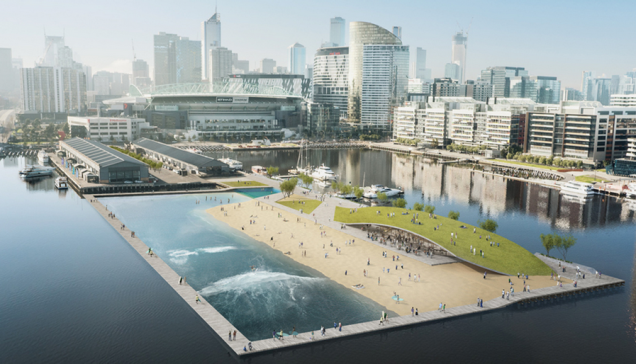Australia has many great surfing coasts, but for some in Melbourne it would be even better to have the option to catch some waves just steps from the city.
Enter the Docklands Surf Park, a project proposal by Arup and Damian Rogers Architecture that involves creating a massive wave pool of sorts near the city's Docklands neighborhood. The surfing pool would offer 98-foot-wide waves that would run the length of the 500-foot-long enclave, reports Australian newspaper The Age.
The project is in the very early stages of its proposal and still far from realization, but that hasn’t stopped the plan from garnering a lot of fanfare and support from Melburnians and surf enthusiasts.
As for the project’s reception from city officials, this is what surfing magazine Stab reports:
“Arup [is] seeking funding from developers and potential operators rather than the government, but Melbourne City Council and Places Victoria would still have to approve construction. Both [organizations] have met with Arup, and a council spokeswoman said it was an 'interesting concept' if private funding were available. The city of Melbourne has yet to officially back the project.”
More on the story at Gizmodo and The Age.
Related Stories
| Oct 5, 2011
GREENBUILD 2011: Brick offers growing options for sustainable building design
Brick exteriors, interiors and landscaping options can increase sustainability that also helps earn LEED certification.
| Oct 5, 2011
GREENBUILD 2011: Roof hatch designed for energy efficiency
The cover features a specially designed EPDM finger-type gasket that ensures a positive seal with the curb to reduce air permeability and ensure energy performance.
| Oct 4, 2011
GREENBUILD 2011
Click here for the latest news and products from Greenbuild 2011, Oct. 4-7, in Toronto.
| Oct 4, 2011
GREENBUILD 2011: Methods, impacts, and opportunities in the concrete building life cycle
Researchers at the Massachusetts Institute of Technology’s (MIT) Concrete Sustainability Hub conducted a life-cycle assessment (LCA) study to evaluate and improve the environmental impact and study how the “dual use” aspect of concrete.
| Oct 4, 2011
GREENBUILD 2011: Johnsonite features sustainable products
Products include rubber flooring tiles, treads, wall bases, and more.
| Oct 4, 2011
GREENBUILD 2011: Nearly seamless highly insulated glass curtain-wall system introduced
Low insulation value reflects value of entire curtain-wall system.
| Oct 4, 2011
GREENBUILD 2011: Ready-to-use wood primer unveiled
Maintains strong UV protection, clarity even with application of lighter, natural wood tones.
| Oct 4, 2011
GREENBUILD 2011: Two new recycled glass products announced
The two collections offer both larger and smaller particulates.
| Oct 4, 2011
GREENBUILD 2011: Mythic Paint launches two new paint products
A high performance paint, and a combination paint and primer now available.

















